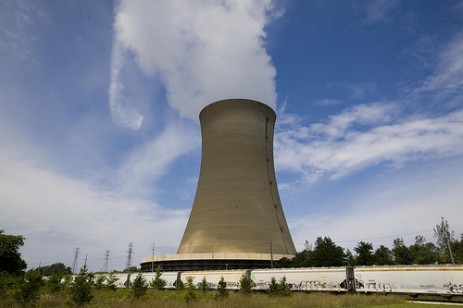 A nuclear plant in Indiana. Photo: Jeremy FarmerYesterday’s Washington Post editorial pretty well mirrors current centrist conventional wisdom on energy policy: carbon tax would have been best, cap-and-trade would have been second best, and the renewable electricity standard (RES) now before the Senate would be third best.
A nuclear plant in Indiana. Photo: Jeremy FarmerYesterday’s Washington Post editorial pretty well mirrors current centrist conventional wisdom on energy policy: carbon tax would have been best, cap-and-trade would have been second best, and the renewable electricity standard (RES) now before the Senate would be third best.
However, say centrists, the RES should be expanded into a “Clean Energy Standard,” allowing other low-carbon energy sources like nuclear and natural gas to qualify. “The government interest is in reducing climate change,” say the editors. “The goal therefore is low-carbon electricity generation.”
This change is widely considered a prerequisite for getting serious support for the policy from conservatives, who are perpetually tumescent when it comes to nuclear power.
Still, it remains a bad idea, one that reflects a common confusion about the purpose of an RES.
A price on carbon is designed to drive down emissions by whatever means turn out to be most cost-effective. It’s a pollution reduction policy. The RES, by contrast, is a species of industrial policy. It stimulates development of a particular set of industries — solar, wind, geothermal, and (sometimes) combined heat and power — in order to create jobs and improve America’s competitive position in growing international markets. Those are distinct goals.
In a world of sane policymaking, an RES would be a complement to a carbon pricing system. It is not, as the WaPo seems to be envisioning it, a substitute or a weaker version of the same thing.
Accepting a complement
Now, lots of economists look with disfavor on industrial policy, what they sniffily refer to as “picking winners.” Such interventions in free trade are considered gauche in our neoliberal age. (This aversion to trade-distorting policies tends to be somewhat selective, but put that aside for the moment.)
Economists tend to argue that reducing carbon pollution is the only credible goal and technology-agnostic, “market-based” policy the only credible means. That ideological stance — and yes, it’s ideological, not scientific — has filtered down to many in elite center and center-left circles. Thus the WaPo says that specifically targeting renewable energy sources for support reflects “the sort of thinking that leads to ever more distorted energy markets in which dozens of government interventions have complex, sometimes unwanted effects and obscure the central goal.” It’s all so … messy (sniff).
I’ve written about this before, so I won’t rehash the whole spiel, but the WaPo’s (quite common) take is off in two ways.
First, WaPo editors blithely ignore the fact that energy markets are already distorted, always have been distorted, and always will be distorted. Governments have a unique interest in the provision of energy and no government in history has left the results up to the “free market.” America has always had industrial policy around energy. It’s just that historically, that policy has overwhelmingly favored fossil fuels over efficiency or alternative sources.
The fact is, all politicians, including those who cluck the loudest about picking winners, love industrial policy when their favored industries are the ones receiving largesse. (John McCain, for instance, has been known to cluck about picking winners and champion nuclear power in the same breath.) The politicians who don’t like the RES don’t like it because it doesn’t benefit their financial contributors, not out of any fealty to free market principles.
The second misconception reinforced by WaPo editors is that there’s just one “central goal” of climate/energy policy. There are, in fact, many overlapping goals, and the wisest course is to match appropriate goals with appropriate tools. Yes, reducing emissions is important, but the RES isn’t primarily designed for that and isn’t a particularly apt tool for it. The RES at issue in the Senate is unlikely to reduce climate pollution at all, and even a more ambitious RES wouldn’t reduce CO2 as much as a carbon price, particularly in the early years.
The goals of an RES are straightforward: jobs and industrial development. It’s precisely those goals that would be obscured by the inclusion of incumbent industries like nuclear and natural gas, which have a long history of prior subsidies.
And another thing
A final note: In the first decade or two of a carbon price being in place, the big emission reductions are going to come from energy efficiency and switching to natural gas. Those are the cheapest and most ready-at-hand options.
After a few decades, though, once reductions are pushing the 40 or 50 percent mark, America will need large new supplies of low-carbon energy. It would be a bad situation indeed if the U.S. waited until then to start standing up its domestic clean energy industries.
So the RES can also be seen as serving a third goal: preparation for a time when virtually all of America’s energy will have to come from renewable sources. That’s going to be an enormous challenge and the best time to start on it is yesterday.
So yeah: Keep yer nukes outta the RES, and if you want to keep in touch with the latest thinking on energy, don’t read The Washington Post.


